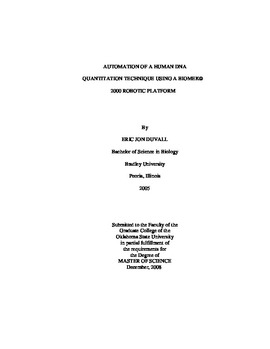| dc.contributor.advisor | Allen, Robert W. | |
| dc.contributor.author | Duvall, Eric Jon | |
| dc.date.accessioned | 2014-04-15T20:25:30Z | |
| dc.date.available | 2014-04-15T20:25:30Z | |
| dc.date.issued | 2008-12-01 | |
| dc.identifier.uri | https://hdl.handle.net/11244/8910 | |
| dc.description.abstract | Increases in entry criteria for CODIS entry coupled with advances in forensic DNA typing have caused a nationwide backlog of samples for processing. The purpose of this study was to automate a novel quantitation assay (Q-TAT) using a Beckman Coulter Biomek 2000 robotic platform. The Q-TAT assay not only provides the concentration of human DNA present for a questioned sample, but also provides information about the gender of contributor(s) and the presence of sample degradation or PCR inhibitors. Pipetting accuracy of the Biomek 2000 pipetting tools was assessed spectrophotometrically using dilutions of a blue dye in water. Standard curves comparing input DNA versus amplified DNA product for both manual and robotic Q-TAT methods were constructed and shown to be equivalent. Mock casework samples were prepared and analyzed using both manual and robotic setups. Quantitation estimates were compared to detect differences in the setup techniques. PCR amplification for the Q-TAT assay was performed using an ABI 9700 thermocycler. Analysis of Q-TAT amplicons was performed on a 310 Genetic Analyzer capillary electrophoresis instrument. Quantitation values were calculated using peak areas generated from GeneMapper software exported to Microsoft Excel spreadsheets. The pipetting validity of the Biomek 2000 was verified through a series of dye studies. The use of the P20 pipetting tool was found to be unreliable for pipetting 1μL volumes. At increased pipetting volumes, the P20 was not significantly different than an analyst using a certified pipette. The P200 pipetting tool also had no significant difference in pipetting volumes from that of a manual setup. The Q-TAT assay was altered such that the amount of template DNA added to the PCR reaction mixture was increased to 5μL. The assay was successfully implemented onto the robotic platform with no significant difference between standard curves generated using manual and robotic means. A mock sample comparison revealed a C.V. of 30.2% between manual and automated pipetting. Suggested improvements for automation include addition of the internal amplification control to the template human DNA as an indicator that DNA was added to the PCR mixture. Other considerations for successfully automating Q-TAT are implementing the necessary quality assurance/quality control practices that apply when dealing with large number of samples, such as organizational sheets and accurate robotic scripts. | |
| dc.format | application/pdf | |
| dc.language | en_US | |
| dc.publisher | Oklahoma State University | |
| dc.rights | Copyright is held by the author who has granted the Oklahoma State University Library the non-exclusive right to share this material in its institutional repository. Contact Digital Library Services at lib-dls@okstate.edu or 405-744-9161 for the permission policy on the use, reproduction or distribution of this material. | |
| dc.title | Automation of a Human DNA Quantification Technique Using a Biomek 2000 Robotic Platform | |
| dc.type | text | |
| dc.contributor.committeeMember | Champlin, Franklin | |
| dc.contributor.committeeMember | Wagner, Jarrad | |
| dc.contributor.committeeMember | Pritchard, Jane | |
| dc.contributor.committeeMember | Fuller, Valerie | |
| osu.filename | Duvall_okstate_0664M_10022.pdf | |
| osu.college | Agricultural Sciences and Natural Resources | |
| osu.accesstype | Open Access | |
| dc.description.department | Department of Biochemistry and Molecular Biology | |
| dc.type.genre | Thesis | |
